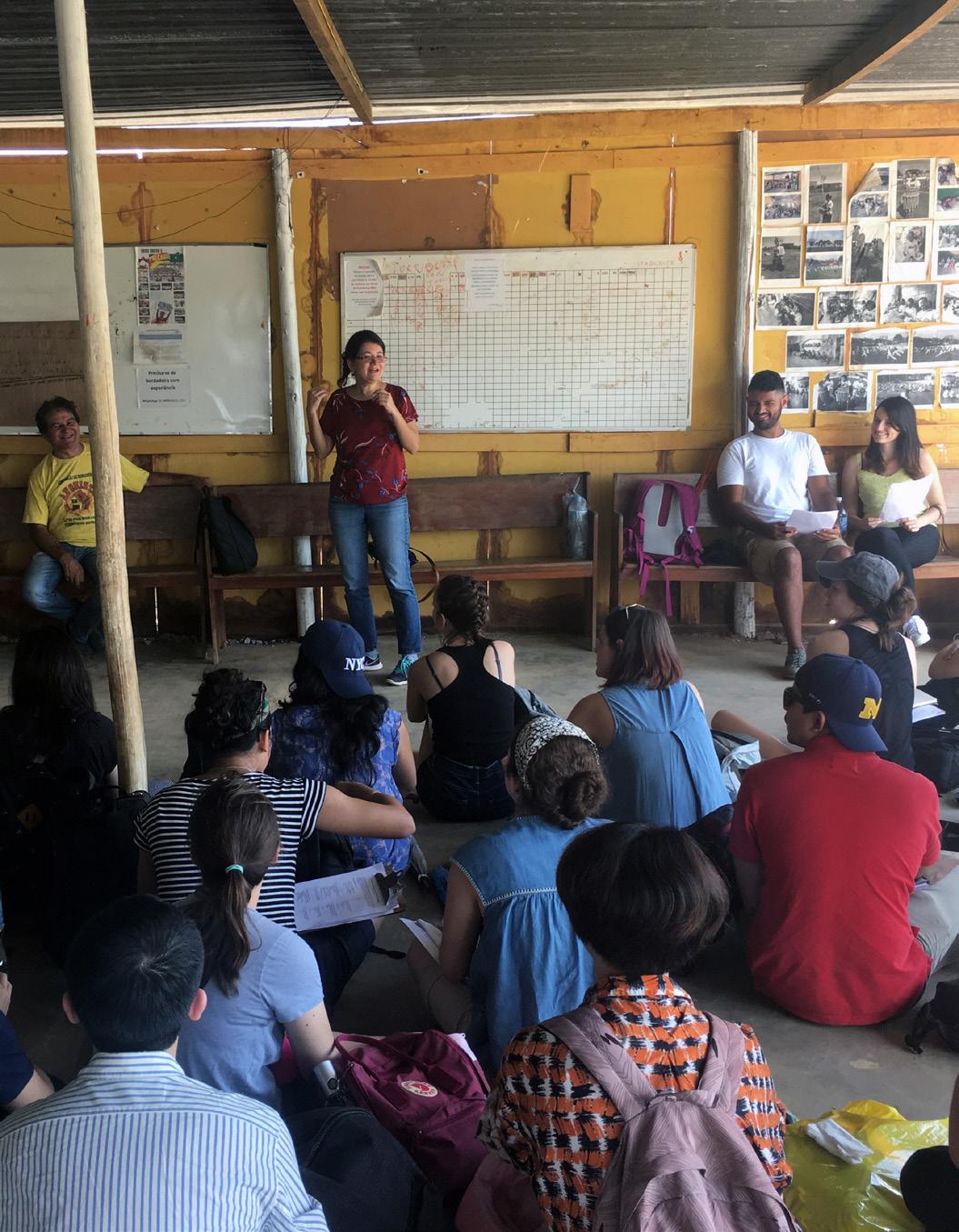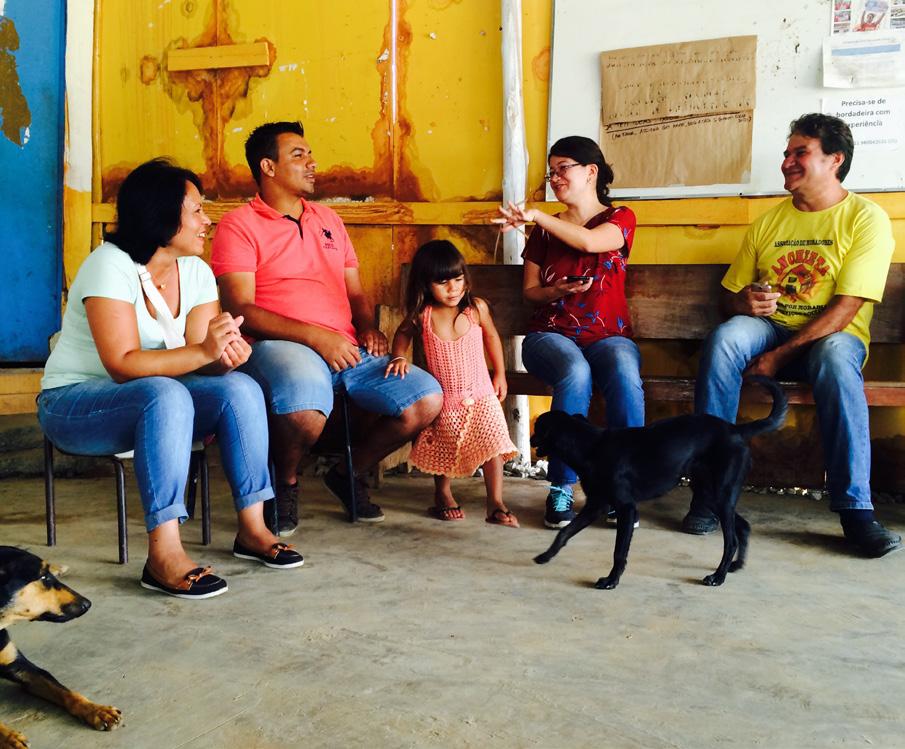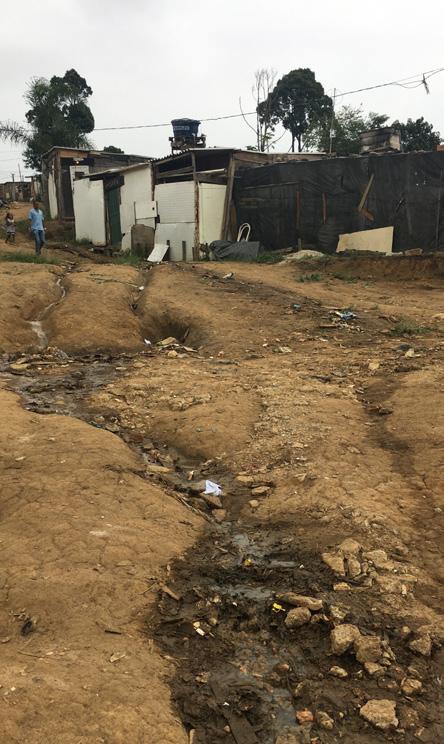
6 minute read
Client-Partner Interview Summary
The client for the Taubman team was Movimiento Anchieta, the leadership of Ocupação Anchieta. Shortly after the foundation of the informal settlement in 2013, residents elected nine different leadership positions. The Movimeinto has led the drive for formality, both with the municipality and with other leftist solidarity organizations throughout the city. The team worked extensively with the leaders of Ocupação Anchieta, and guided the Taubman team during the direct observation and client interviews.
39 (left) Client-Partner Interview at Neighborhood Association’s Headquarters.
Due to a lack of internet in the Occupation, Taubman College Team had limited communication with the Association, between the faculty’s first visit to the community in October 2016 and the fieldwork trip with students in FebruaryMarch 2017. When Taubman Team students first arrived on, they first conducted a group interview with four of the Association’s coordinators. This interview provided qualitative data on the Association’s history, challenges, successes, and goals for the future. Additionally, the students asked the coordinators questions regarding relations with other organizations, the landowner (IAG), and the municipal government; their funding sources; housing needs; and the community’s infrastructure. The interview lasted three hours and continued through lunch.
The client-partner interview was flexible, giving enough time for the coordinators to produce their own narratives. Beforehand, students created a list of pertinent questions that were also asked. The interview guide serves to remind the interviewer to ask about certain topics that have not been discussed during the interview (Taylor, J., Bogdan, and DeVault, 2015). The Taubman College Team met with residents Moacyr (Movimento Anchieta president), Fernando, Anderson, Beth, and all coordinators of the Movement and Association. Professor Pimentel Walker acted as the facilitator and translator for these interviews. Conversations were productive and helped develop a better understanding about the site.
Prior to the Occupation formation, the land was a dumping ground for stolen car parts, despite IAG’s plans to develop the site. The Association estimates that approximately 600-700 families
live on the site today. The Association is no longer accepting new residents; newcomers to the community are redirected to another occupation about twenty minutes away.
The first association formed at the Occupation charged the residents for dues: R$20 ($6.36 USD) for homes and R$30 ($9.53 USD) for businesses. However, residents grew suspicious of how former coordinators used these funds and called for elections. For these reasons, the Association’s current coordinators do not collect money from residents. Instead, community projects that require funding are funded by donation from campaigning politicians.
Ocupação Anchieta has a complicated legal situation. Brazilian law implies that land must serve a social function. If a property owner holds on to land for speculation purposes, the government can apply progressive taxation and/or revoke the land title. For more information on the social function of urban property under Brazilian law, see the São Paulo volume that our team produced.
Nonetheless, the property owners attempted to evict occupants three times by filing actions in court. By the third lawsuit, IAG and Ocupação Anchieta, counseled by public defenders, reached an agreement that provided the Occupation with temporary use rights in exchange for dropping the eviction lawsuit. Today, the Association and IAG are in constant negotiation, striving to find the best way to satisfy both of their interests.
The community organizes a number of social and cultural activities, which Association Coordinators claim is Ocupação Anchieta’s greatest assets. Residents celebrate Christmas, Children’s Day, Father’s Day, and hold an annual Mother’s Day party with hair and makeup activities.
There are a number of businesses within the community, such as hair salons, bars, bakeries, and convenience shops. For some residents, the local businesses are side jobs, but for many the business is their main source of income. In addition to businesses, three churches exist within the community, and the Association is hoping to build a Catholic church soon.
The Institute provides after school programming for four hours during school days. IAG receives 600 children from the surrounding communities, 300 from Ocupação Anchieta. There is hope that a new school will be built near the football (American soccer) field in the community. Currently, Ocupação Anchieta children have transit passes to take public transportation to go to school or parents opt for an informal rented van that brings kids to school in the district.
Ocupação Anchieta Association manages Movimento Anchieta (the Movement), a social movement formed four years ago at the Occupation. Movimento Anchieta focuses on community organizing and activism, while the Association manages neighborhood planning and daily life activities.
The Association has leadership elections every four years. Positions include president, vice president, secretary, and treasurer. In total, there are nine coordinators. Both the Movement and the Association operate on a volunteer basis. Coordinators do not receive payment for their work. The Association also holds monthly meetings, through which community members participate intensively. The Association organizes meetings and

40 Convenience Shops Provide Goods and Services, and Become Gathering Places.
protests via WhatsApp, paper flyers, and word of mouth. In its first two years of operation, the Movement was ineffective in serving resident needs. After community elections and a change in leadership, residents continued the Movement and fighting for their rights. The largest complaint about the community is that noise carries from one house to the next because homes are constructed with materials that easily permit the transfer of sound.
The coordinators explained various ways households manage water, electricity, and sewage. In some homes, wastewater empties into the creek without treatment. Due to the topography of the community, water runoff also joins the creek, causing further contamination. Homes informally connect to the municipal water system via rubber hoses, known as gato. Some households store water in blue tanks adjacent or on top of their homes. One blue tank is R$150 ($47 USD). Houses also informally connect to the municipal electricity. Sewage is contained in a septic tank or a network of several septic tanks. For more detailed information, refer to Infrastructure and Creeks and Springs Action Plans.
On behalf of the community, the Association coordinators say they would like to have sewerage infrastructure because human waste is severely impacting the environment. Coordinators are considering how to relocate houses to establish this system. Waste

41 Client-Partner Interview with Ana Paula Pimentel-Walker.
management in the Occupation is minimal. The municipality collects the Occupation’s waste from nearby caçambas (dumpsters) where residents dispose of their household trash. The coordinators explained that most parents tell their children to walk the trash to the dumpsters; however, children often get distracted and leave trash scattered throughout the community. Two residents informally collect recyclables doorto-door in the community. These residents sell the recyclables to someone outside of the community as their livelihoods.
Four water springs (minas) and a creek are located in the community. Some families initially built their homes in these areas,
causing deforestation and water pollution. The Occupation is working with residents to relocate these homes to other areas in the community. In October 2016, the TETO NGO assisted in relocating 111 homes by the creek. Today, only thirty homes remain in this area. For seventeen of these 30 remaining houses, construction of new homes has already began. Each house costs the NGO about R$ 8000 ($2,542 USD), of which families contribute R$200 ($63.56 USD).
Construction materials for homes are found in the community or surrounding areas. Oftentimes, these are leftover materials from other home construction projects, old furniture, and/or plywood. Some residents may save money to buy materials. Common materials such as plywood and sheets of tin/metal for roofs can cost about, R$70-80 ($22-25 USD). Women typically construct the homes, which take two days to complete. Housing may contain three to four different rooms, with occasional expansion depending on family size.
In conclusion, the client-partner interview was invaluable to learning more about the residents and Ocupação Anchieta. The Association coordinators provided narratives about the history, assets and needs of the young community. Furthermore, the coordinators were very receptive and helpful in answering questions.

42 Dirt Streets with Surface Runoff Show Demand for Sewage Infrastructure.






